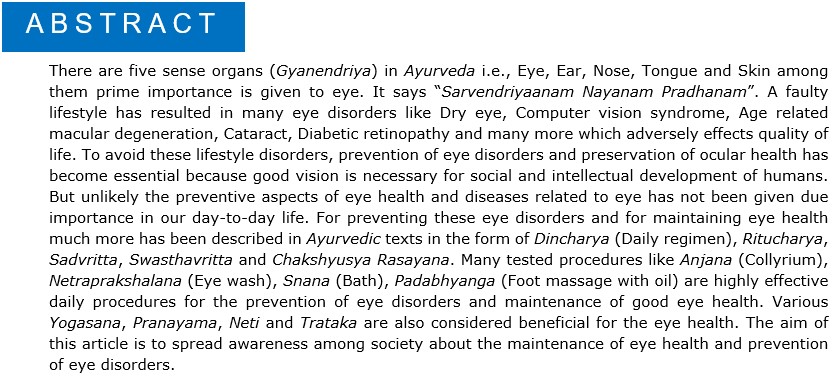Maintenance of Ocular Health by Ayurveda
DOI:
https://doi.org/10.21760/jaims.9.3.26Keywords:
Preventive ophthalmology, Ayurveda, Lifestyle eye disorders, Eye careAbstract
There are five sense organs (Gyanendriya) in Ayurveda i.e., Eye, Ear, Nose, Tongue and Skin among them prime importance is given to eye. It says “Sarvendriyaanam Nayanam Pradhanam”. A faulty lifestyle has resulted in many eye disorders like Dry eye, Computer vision syndrome, Age related macular degeneration, Cataract, Diabetic retinopathy and many more which adversely effects quality of life. To avoid these lifestyle disorders, prevention of eye disorders and preservation of ocular health has become essential because good vision is necessary for social and intellectual development of humans. But unlikely the preventive aspects of eye health and diseases related to eye has not been given due importance in our day-to-day life. For preventing these eye disorders and for maintaining eye health much more has been described in Ayurvedic texts in the form of Dincharya (Daily regimen), Ritucharya, Sadvritta, Swasthavritta and Chakshyusya Rasayana. Many tested procedures like Anjana (Collyrium), Netraprakshalana (Eye wash), Snana (Bath), Padabhyanga (Foot massage with oil) are highly effective daily procedures for the prevention of eye disorders and maintenance of good eye health. Various Yogasana, Pranayama, Neti and Trataka are also considered beneficial for the eye health. The aim of this article is to spread awareness among society about the maintenance of eye health and prevention of eye disorders.
Downloads
References
Kumar P.S, Dash S, Concept of preventive ophthalmology in Ayurveda. Int. J. Res. Ayurveda Pharm. Mar-Apr 2016;7(Suppl 2):115-119.
Tripathi R.D, Shukla Vidyadhara. Charak Samhita Vol.1 (Sutra Sthana 5/18,19). Vaidyamanorama Hindi Commentary. Delhi; Chaukhamba Sanskrit Pratisthana;2007.p-92
Shastri A. D., Sushruta Samhita Vol.1 (Chikitsa Sthana 24/15,16,17). Ayurveda Tatva Sandipika Hindi Commentary. Varanasi; Chaukhambha Sanskrit Sansthan; 2012. p-132.7
Misra B.,Veisya Shri R.. Bhava PrakashVol.1 (5/318). Vidyotini Hindi Commentary.Varanasi; Chaukhambha Sanskrita Sansthana; 2004. p-150.
Shastri A. D., Sushruta Samhita Vol.1 ( Chikitsa Sthana 24/59). Ayurveda Tatva Sandipika Hindi Commentary. Varanasi; Chaukhambha Sanskrit Sansthan; 2012. p-135
Shastri A. D. Sushruta Samhita Vol.1 (Chikitsa Sthana 24/69). Ayurveda Tatva Sandipika Hindi Commentary. Varanasi; Chaukhambha Sanskrit Sansthan; 2012, p-136.
Tripathi R.D, Shukla Vidyadhara. Charak Samhita Vol.1 (Sutra Sthana 5/90,91,100). Vaidyamanorama Hindi Commentary. Delhi; Chaukhamba Sanskrit Pratisthana; 2007. p-101,102.
Tripathi B. Astanga Hridayam of Vagbhatta (Uttarasthan 16/66). Hindi commentary. Delhi; Chaukhamba Sanskrit Pratisthan; 2014. p-998.
Tripathi B. Astanga Hridayam of Vagbhatta, Hindi Commentary, Sutrasathana 2/17, Chaukhamba Surbharti Pratisthan, new delhi, Edition-Reprint, 2014;32
Shastri Kashinath, Charaka Samhita Vidyotini Hindi Commentary, Sutrasathana 5/58, Chaukhamba Sanskrit Pratisthan, Edition-Reprint, 2012;85
Shastri Kashinath, Charaka Samhita Vidyotini Hindi Commentary, Sutrasathana 5/10, Chaukhamba Sanskrit Pratisthan, Edition-Reprint, 2012;89
Shastri A.D, Sushruta Samhita Vol.1(Chikitsa Sthana 40/7,8). Ayurveda Tatva Sandipika Hindi Commentary. Varanasi; Chaukhambha Sanskrit Sansthan; 2012. p- 222.
Tripathi R.D. Shukla Vidyadhar, Charaka Samhita vol. 1 (Sutra Sthana 5/28,36). Vaidyamanorma Hindi Commentary. Delhi; Caukhamba Sanskrit Pratisthan; 2007. p.93.
Gupta A, Astanga Hiradayama (Sutra Sathana 2/8). Vidyotini Hindi Commentary. Varansi; Chaukhamba Prakashan; 2012.p-24.
Jadavaji Trikumji Acharya, Sushruta Samhita, Dalhana commentary, Chikitsasthana 24/26, choukhamba surbharati prakashan, Edition-Reprint, 1994; 396.
Shantakumari.P.K. Text book of ophthalmology in Ayurveda, 2nd edition, 2009; 391.
Jadavaji Trikumji Acharya, Sushruta Samhita, Dalhana commentary, Chikitsasthan 24/65, choukhamba surbharati Prakashan, Edition-Reprint, 1994; 397















